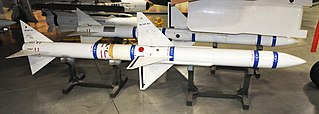
The AIM-7 Sparrow is an American medium-range semi-active radar homing air-to-air missile operated by the United States Air Force, United States Navy, United States Marine Corps, and various other air forces and navies. Sparrow and its derivatives were the West's principal beyond visual range (BVR) air-to-air missile from the late 1950s until the 1990s. It remains in service, although it is being phased out in aviation applications in favor of the more advanced AIM-120 AMRAAM.

The Maestrale class is a class of frigates of the Italian Navy. The class is composed of eight vessels, all of which were built by Fincantieri S.p.A., Riva Trigoso, except for Grecale, which was built by Fincantieri S.p.A. – Muggiano, La Spezia.

The Aster 15 and Aster 30 are a Franco-Italian family of all-weather, vertical launch surface-to-air missiles. The name "Aster" stands for "Aérospatiale Terminale", with French company Aérospatiale having been the project's lead contractor before its missile activities were merged into MBDA. It also takes inspiration from the word "aster", meaning "star" in Ancient Greek. The missiles as well as the related weapon systems are manufactured by Eurosam, a consortium consisting of MBDA France, MBDA Italy and Thales, each holding a 33.3% share.

The MICA is a French anti-air multi-target, all weather, fire-and-forget short to medium-range missile system manufactured by MBDA France. Its name is an abbreviation of Missile d'Interception, de Combat et d'Auto-défense. It is intended for use both by air platforms as individual missiles as well as ground units and ships, which can be equipped with the rapid fire MICA Vertical Launch System. It is fitted with a thrust vector control (TVC) system. It was developed from 1982 onward by Matra. The first trials occurred in 1991, and the missile was commissioned in 1996 to equip the Rafale and Mirage 2000. It is a replacement for both the Super 530 in the interception role and the Magic II in the dogfighting role. MICA-EM and MICA-IR both can fulfill the roles of short-range and medium range BVR air to air missiles.

The RIM-7 Sea Sparrow is a U.S. ship-borne short-range anti-aircraft and anti-missile weapon system, primarily intended for defense against anti-ship missiles. The system was developed in the early 1960s from the AIM-7 Sparrow air-to-air missile as a lightweight "point-defense" weapon that could be retrofitted to existing ships as quickly as possible, often in place of existing gun-based anti-aircraft weapons. In this incarnation, it was a very simple system guided by a manually aimed radar illuminator.

The Oerlikon GDF or Oerlikon 35 mm twin cannon is a towed anti-aircraft gun made by Oerlikon Contraves. The system was originally designated 2 ZLA/353 ML but this was later changed to GDF-001. It was developed in the late 1950s and is used by around 30 countries.
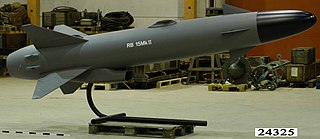
The RBS 15 is a long-range fire-and-forget surface-to-surface and air-to-surface anti-ship missile. The later version Mk. IV has the ability to attack land targets as well. The missile was developed by the Swedish company Saab Bofors Dynamics.

The Algerian Naval Force is the naval branch of the Algerian military. The naval force operates from multiple bases along the country's nearly 1,440 km (890 mi) coastline, fulfilling its primary role of monitoring and defending Algeria's territorial waters against all foreign military or economic intrusion. Additional missions include coast guard and maritime safety missions as well a projection of marine forces. Algerian forces are an important player in the Western Mediterranean. The Algerian navy ranks 15th globally in the world's most important naval forces report of 2023.

The Laksamana class is a class of small missile corvettes comprising four ships currently in service with the Royal Malaysian Navy. All four ships of the Laksamana class are currently serving in the 24th Corvette Squadron of the Royal Malaysian Navy.

The Otomat is an anti-ship and coastal defence missile developed by the Italian company Oto Melara jointly with Matra and now made by MBDA. The name comes, for the first versions, from the name of the two builders and, for the later versions, Teseo, from the Italian word for Theseus. The MILAS variant is an anti-submarine missile. In its latest version Mk/2E purchased by the Italian Navy is a medium range anti-ship missile and a ground attack missile.
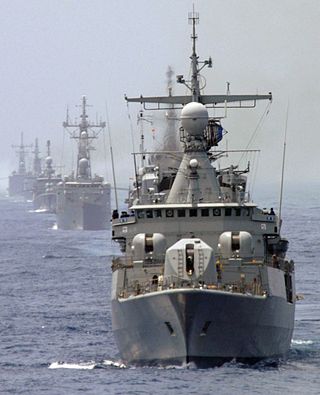
The MEKO 360 is a class of five ships built in Germany for the Argentine and Nigerian navies. The MEKO 360 was the first version of the MEKO family of vessels built by Blohm und Voss. The type comes in two variants, the MEKO 360H1, comprising one ship, and the MEKO 360H2, comprising four ships. They are alternatively classed as frigates and destroyers by different sources. The design is based on the modular concept which allows swapping out different armaments to fit mission requirements and allows for easier application of upgrades and refits.
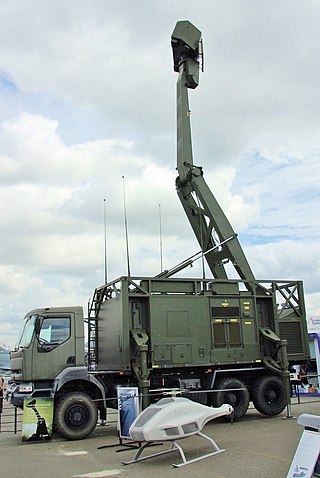
The Saab Giraffe Radar is a family of land and naval two- or three-dimensional G/H-band passive electronically scanned array radar-based surveillance and air defense command and control systems. It is tailored for operations with medium- and Short Range Air Defense (SHORAD) missile or gun systems, or for use as gap-fillers in a larger air defense system.

The Aeritalia F-104S Starfighter was a licensed production Italian version of the Lockheed F-104 Starfighter, which served in the Italian Air Force, and was its mainstay from the late 1960s until the beginning of the 21st century. The F-104S also served in the Turkish Air Force until the mid-1990s. The F-104S was the final development of the Starfighter line.
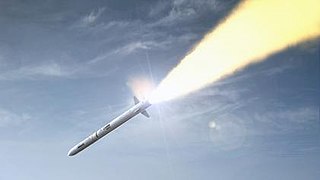
The CAMM is a family of surface-to-air missiles developed by MBDA UK for the United Kingdom. CAMM is derived from, and shares some common features and components with, the Advanced Short-Range Air-to-Air Missile (ASRAAM), but with updated electronics, a soft vertical launch system, and an active radar homing seeker. The CAMM family is in use by or on order for the armed forces of several countries.

The MEKO 200 is a frigate design by the Blohm + Voss shipyard of Germany, as part of the MEKO family of warships.
Dat Assawari was a frigate operated by the Libyan Navy. The ship was built by VT Group in the United Kingdom. It was ordered in February 1968 and delivered in 1973. The ship's design, the Vosper Mk 7 is a modified version of the Alvand-class frigate built for the Iranian Navy. The ship had an extensive refit in Italy by CNR Riva Trigoso 1979–1980 when new sensors and missiles were installed. During the refit, the ship was mined by French commandos from SDECE. The vessel returned to service in 1983, but returned to Italy for repairs in 1984–1985 and 1989–1990. The frigate was reportedly scrapped in the late 1990s.

The TRML is a family of air defense radars first developed by Telefunken and currently produced by Hensoldt. It is a development of the earlier TRMS.
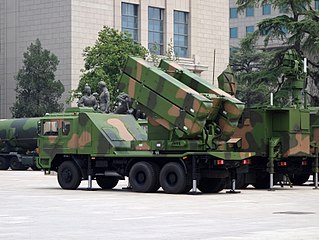
The HQ-6, also known as LY-60, is a family of Chinese air defense missiles developed by the Shanghai Academy of Science and Technology, largely based on the Chinese PL-11 and Italian Selenia Aspide missile.

The Esmeraldas-class corvettes are a class of corvette in service with the Ecuadorian Navy, built in Italy by Fincantieri, entering service in the early 1980s.
























